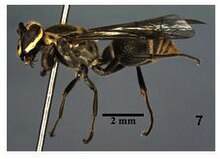Protonectarina
| Protonectarina | |
|---|---|
 |
|
| Scientific classification | |
| Kingdom: | Animalia |
| Clade: | Euarthropoda |
| Class: | Insecta |
| Order: | Hymenoptera |
| Family: | Vespidae |
| Subfamily: | Polistinae |
| Tribe: | Epiponini |
| Genus: | Protonectarina |
| Species: | P. sylveirae |
| Binomial name | |
|
Protonectarina sylveirae (Saussure, 1854) |
|
| Synonyms | |
|
Polybia enxuy (Smith, 1863) |
|
Polybia enxuy (Smith, 1863)
Protonectarina sylveirae, commonly referred to as the Brazilian wasp, is a neotropical swarm-founding wasp species that ranges widely across South America. This species relies heavily on the consumption of animal protein rather than nectar. P. sylveirae preys heavily on agricultural pests to coffee crops, keeping pest populations low.
P. sylveirae belongs to the order Hymenoptera, which contains roughly 100,000 species of bees, ants, and wasps. The species belongs to the eusocial tribe Epiponini, which is characterized by complex nests, morphological differences between castes, and the occurrence of reproductive polygyny. P. sylveirae is the only species within its genus, and is most closely related to genera Polybia and Protopolybia.
Protonectarina is characterized by its relatively hairy eyes, and can be diagnosed by the width of the clypeus, or the front of the head. Queens have a lighter-colored body and a wider, brown spotted clypeus region compared to that of workers. The clypeus in workers features a black, horseshoe-shaped marking that varies widely among individuals. Queens are typically larger than workers, but this varies from colony to colony: a queen may even be identical in size to the workers in its colony. Age of an P. sylveirae individual can be determined from the pigmentation of the transverse apodeme across the hidden base of the fifth sternum. As a wasp ages, pigment gradually accumulates, and this region darkens.
The distribution of P. sylveirae is wide and stretches from Brazil to Argentina. The species builds nests in trees, typically suspended from twigs. Nests are built from foraged cellulose mashed with water, which forms a papery substance used to construct walls. Cylindrical nests are constructed as a series of enclosing envelopes. When building a nest, the first envelope is built from the substrate, and each subsequent envelope is added to that base. The seams between cells are characteristically irregular, and a simple entrance is built on the ventral surface of the structure. An average nest may have around 50 combs, but nests can be quite large, sometimes 30–40 centimeters long.
...
Wikipedia
